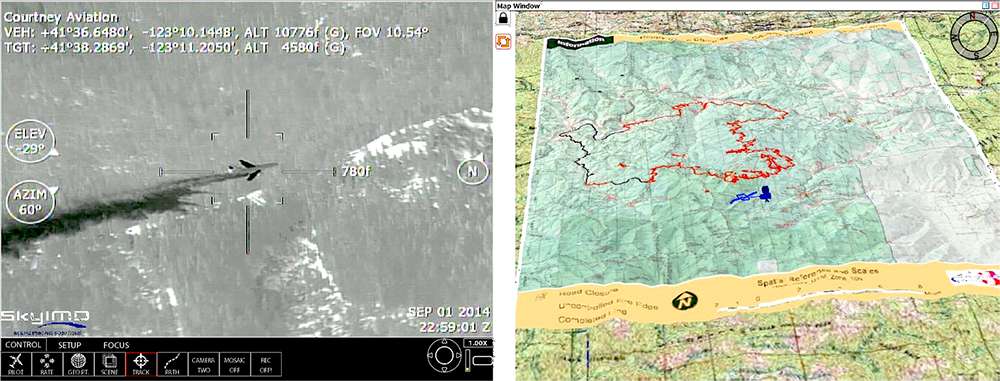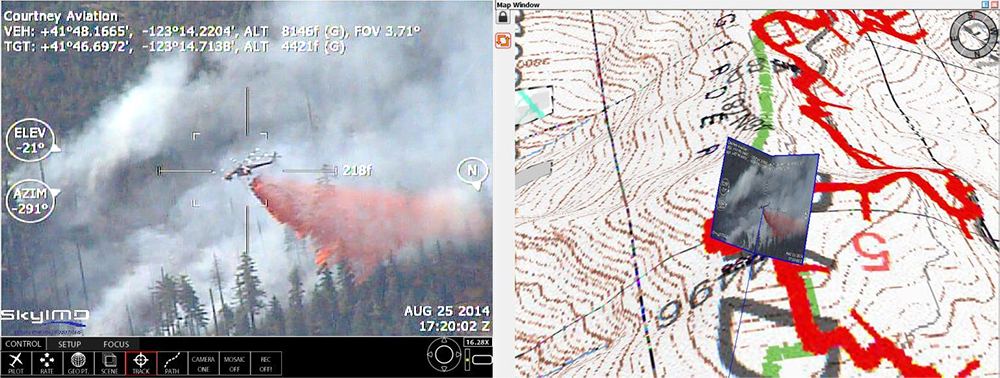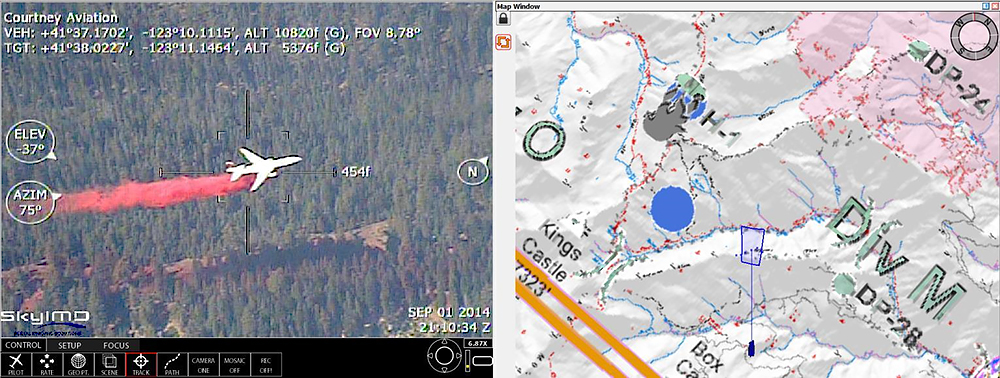October 15, 2014 — SkyIMD combined UAV (Unmanned Aerial Vehicles) and manned aircraft technologies on the Happy Camp Complex wildfire to reduce workloads and increase team effectiveness in ways previously not possible. SkyIMD installed a lightweight UAV gimbal on a normal manned Air Attack aircraft.
Live in the cockpit, wildfire visualization provided:
- Instant situational awareness of fire lines and mountains through smoke blocked skies
- Video recording, mapping retardant drops, and live automatic tracking of firefighting aircraft
- Retardant coverage level analysis discovering creeping fire threads through firebreaks
- Over-the-Air (OTA) update of current fire maps onto the split screen moving map
- Low latency ground operation over self-healing microwave automatic mesh network and the internet
- Multi-hop 20 Mb mesh covered the whole fire, with single node distance of 28 miles
Remote control of airborne stabilized camera EO/IR (Electro Optical/Infrared) gimbals designed for UAVs is available through SkyIMD SkyFusion Pak for fixed wing, rotorcraft, and UAVs. Systems support fully automated 3D geo-tracking of static locations or GIS (Geographic Information System) fire lines comprising of thousands of points. Advanced object recognition provides hands-off following of aircraft and vehicles. Satellite and 3G connectivity delivers streaming video or snapshots over the internet to any iPhone, Android, or computer.
“Infrared stops fire from hiding in its own smokescreen,” says Hart Drobish (President of Courtney Aviation, the Air Attack Operator). “SkyIMD makes an extremely sophisticated tool intuitive for first time users. Without training, Air Attacks see through smoke. Zoomed in, IR identifies fire creeping through retardant that is too late once visible to the naked eye.” Hart is developing IR solutions on multiple platforms to extend coverage.
The Planning Section Chief responsible for intelligence, strategy, and objectives at the Incident Command Post (ICP) operated the FLIR infrared sensor when the cockpit crew was busy managing airspace. The Chief of the Happy Camp Complex fire could click the fire map or touch the live video to “walk around” deep in the burn. The new spot fires discovered were then verified by the aircrew. Using the same remote control, SkyIMD in San Francisco interactively trained the Chief who had never before operated an EO/IR superzoom gimbal. The easy interface took only a few minutes to learn and become a valuable asset.
“Seeing through the smoke is indispensable,” says Air Attack Dick Stiliha (ATGS, Air Tactical Group Supervisor). “I hope to never be without infrared again. Sharing live video with ICP was very beneficial. Equally valuable, recorded video was used for daily post mission debrief to improve tanker pilots’ effectiveness and safety.”
“The only growing-pain with remote controlling the airborne infrared was that so many people wanted to use it,” says Henri Wolf (SkyIMD CTO and former wildfire tanker pilot). “Since drones are not currently approved for wildfires, some aerial firefighters would like to use the same cameras on a manned-drone parked out of the way, above the congested fire attack altitudes. A ground operated gimbal flown solo, a manned UAV, will provide all the benefits of a UAS, extending ICP’s vision while relieving workload, and has the potential to evolve into an unmanned aircraft in the future.”
SkyIMD and Courtney Aviation are developing techniques to use UAV technology in manned aircraft, as well as to fly active missions collaboratively. Manned UAVs naturally handle the airspace above UAVs (400 ft. altitude ceiling), and below satellites (orbiting at 22,000 miles). Development is in progress to share airspace symbiotically, enabling both manned and unmanned to perform in ways not possible separately.
SkyIMD will exhibit and demo manned UAVs, also known as surrogate drones, at the ASPRS UAV symposium in Reno, NV on October 21 and 22. In an adjoining meeting, the US Forest Service and NASA Tactical Fire Remote Sensing Advisory Committee (TFRSAC) have requested SkyIMD to present the Happy Camp success, and investigate standardizing operational procedures.
Infrared of DC-10 Very Large Air Tanker dropping retardant on Happy Camp Complex Wildfire
Retardant delivered to wildfires by tankers can have coverage shadows from fallen trees. SkyIMD infrared allows Air Attacks to inspect for adequate coverage, and later discover fire threading through, before it is too late.
Video of a Sky Crane dropping retardant on the Happy Camp Complex wildfire transmitted live to the ground Incident Command
Live microwave linked 28 miles to SkyIMD’s IR/EO from the base station. Live control occurred in the field, and was transferred through the internet to Incident Command, where the Planning Section Chief could operate the superzoom gimbal.
Retardant delivered by a DC-10 on the Happy Camp Complex wildfire is captured on video for post mission debrief
Air Attacks who are very busy managing all air operations over wildfires, track incoming tankers hands-off with optical image recognition built into SkyIMD SkyFusion Pak. Lock-on is achieved by touching the target on the video display, or clicking it.



